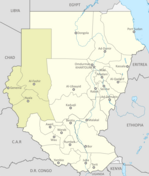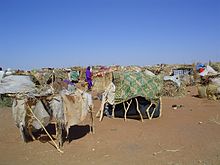| Darfur دار فور | ||
|---|---|---|
| Capital | TDRA: Khartoum North Darfur: Al-Fashir South Darfur: Nyala West Darfur: Geneina | |
| Official language(s) | Arabic and English | |
| Demonym | Darfuri | |
| Government | interim administration | |
| - | Chairperson of the TDRA | Shartai Jaafar Abdel Hakam [1] |
| - | Governor of North Darfur | Osman Mohamed Yousif Kibir |
| - | Governor of South Darfur | Abdel Hamid Musa Kasha |
| - | Governor of West Darfur | Shartai Jaafar Abdel Hakam |
| Area | ||
| - | Total | 493,180 km2 190,418 sq mi |
| Population | ||
| - | estimate | 6,000,000 (pre-conflict) (2004) |
Darfur (Arabic: دار فور dār fūr, lit. "realm of the Fur") is a region in western Sudan. An independent sultanate for several hundred years, it was incorporated into Sudan by Anglo-Egyptian forces in 1916. The region is divided into three federal states: West Darfur, South Darfur, and North Darfur which are coordinated by a Transitional Darfur Regional Authority. Because of the war in Darfur waged by the Sudanese government against the non-Arab indigenous population, the region has been in a state of humanitarian emergency since 2003.
Contents[hide] |
[edit] Geography
Darfur covers an area of some 493,180 square kilometers (190,420 sq mi)[2]—approximately the size of Spain.[3][4][5] It is largely an arid plateau with the Marrah Mountains (Jebel Marra), a range of volcanic peaks rising up to 3,042 meters (9,980 ft) of topographic prominence,[6] in the center of the region. The region's main towns are Al Fashir, Nyala, and Geneina.
There are four main features of the physical geography. The whole eastern half of Darfur is covered with plains and low hills of sandy soils, known as goz, and sandstone hills. In many places the goz is waterless and can only be inhabited where there are water reservoirs or deep boreholes. While dry, goz may also support rich pasture and arable land. To the north the goz is overtaken by the desert sands of the Sahara. A second feature are the wadis, which range from seasonal watercourses that flood only occasionally during the wet season to large wadis that flood for most of the rains and flow from western Darfur hundreds of miles west to Lake Chad. Many wadis have pans of alluvium with rich soil that are also difficult to cultivate. Western Darfur is dominated by the third feature, basement rock, sometimes covered with a thin layer of sandy soil. Basement rock is too infertile to be farmed, but provides sporadic forest cover that can be grazed by animals. The fourth and final feature are the Marrah Mountains, volcanic plugs created by a massif, that rise up to a peak at Deriba crater where there is a small area of temperate climate, high rainfall and permanent springs of water.
Remote sensing has detected the imprint of a vast underground lake under Darfur. The potential water deposits are estimated at 19,110 square miles (49,500 km2). The lake, during epochs when the region was more humid, would have contained about 2500km3 (607 cubic miles) of water.[7] It may have dried up thousands of years ago.[8]
[edit] History

Darfur is conjectured to have been part of the Proto-Afro-Asiatic Urheimat in distant prehistoric times (c. 10,000 BC), though there are numerous other theories that exclude Darfur.
Most of the region is a semi-arid plain and thus insufficient for supporting a large and complex civilization. While the Marrah Mountains offer plentiful water, the Daju people created the first known Darfurian civilization based in the mountains, though they left no records beside a list of kings. The Tunjur displaced the Daju in the fourteenth century and introduced Islam. The Tunjur sultans intermarried with the Fur and sultan Musa Sulayman (reigned c.1596 to c.1637) is considered the founder of the Keira dynasty. Darfur became a great power of the Sahel under the Keira dynasty, expanding its borders as far east as the Atbarah River and attracting immigrants from Bornu and Bagirmi. During the mid-18th century the country was wracked by conflict between rival factions, and external war with Sennar and Wadai. In 1875, the weakened kingdom was destroyed by the Egyptian ruler set up in Khartoum, largely through the machinations of Sebehr Rahma, a slave-trader, who was competing with the dar[disambiguation needed] over access to ivory in Bahr el Ghazal to the south of Darfur.
The Darfuris were restive under Egyptian rule, but were no more predisposed to accept the rule of the self-proclaimed Mahdi, Muhammad Ahmad, when in 1882 his Emir of Darfur, who was from the Southern Darfur Arab Rizeigat tribe led by Sheikh Madibbo, defeated the British forces led by Slatin Pasha (that had just invaded Egypt earlier that year) in Darfur. When Ahmad's successor, Abdallahi ibn Muhammad, himself an Arab of Southern Darfur from Ta’isha tribe, demanded that the pastoralist tribes provide soldiers, several tribes rose up in revolt. Following the overthrow of Abdallahi at Omdurman in 1899 by the Anglo-Egyptian forces, the new Anglo-Egyptian government recognized Ali Dinar as the sultan of Darfur and largely left the dar to its own affairs except for a nominal annual tribute. During World War I, the British, being concerned that the sultanate might fall under the influence of Ottoman Empire, invaded and incorporated Darfur into the Anglo-Egyptian Sudan in 1916. Under colonial rule, financial and administrative resources were directed to the tribes of central Sudan near Khartoum to the detriment of the outlying regions such as Darfur.
[edit] Conflict
This pattern of skewed development continued following national independence in 1956. To this was added an element of political instability caused by the proxy wars between Sudan, Libya and Chad. The influence of an ideology of Arab supremacy propagated by Libyan leader Muammar al-Gaddafi that began to be acted upon by Darfurians, including those identified as "Arab" and "African". A famine in the mid-1980s disrupted many societal structures and led to the first significant fighting amongst Darfuris. A low level conflict continued for the next 15 years, with the government coopting and arming Arab Janjaweed militias against its enemies. The fighting reached a peak in 2003 with the beginning of the Darfur conflict, in which the resistance coalesced into a roughly cohesive rebel movement. The conflict soon came to be regarded as one of the worst humanitarian disasters in the world. The insurgency and counter-insurgency has led to 480,000 deaths, though the numbers are disputed by the Khartoum government. Over 2.8 million people have been displaced since the beginning of the conflict. Many of these refugees have gone into camps where emergency aid has created conditions that, although extremely basic, are better than in the villages, which offer no protection against the various militias that operate in the region.
[edit] Peace process
[edit] Darfur Peace Agreement
| War in Darfur |
|---|
 |
| Timeline |
| International response |
| UNMIS / AMIS / UNAMID |
| Combatants |
| SLM |
| JEM |
| LJM |
| Janjaweed |
| Other articles |
| History of Darfur |
| Bibliography |
A Darfur Peace Agreement between the Government of Sudan and the Sudan Liberation Movement of Minni Minnawi was signed in 2006. The agreement was only signed by one rebel group, the Sudan Liberation Movement, and rejected by the Justice and Equality Movement resulting in continuation of the conflict. The agreement includes provisions for wealth sharing, power sharing and established a Transitional Darfur Regional Authority to help administer darfur until a referendum could be held on the future of the region. The leader of the Sudan Liberation Movement, Minni Minnawi was appointed Senior Assistant to the President of Sudan and Chairman of the transitional authority in 2007.
In December 2010 the Sudan Liberation Movement withdrew from the peace agreement and the regional authority. Its leader Minni Minnawi fled to Southern Sudan and has since been dismissed as Senior Assistant to the President of Sudan and as Chairman of the Transitional Darfur Regional Authority. [9] The new Chairman Shartai Jaafar Abdel Hakam subsequently dismissed 10 other members of the Sudan Liberation Movement from the authority. [10]
[edit] Doha peace forum
In December 2010, representatives of the Liberation and Justice Movement, an umbrella organisation of ten rebel groups formed in February 2010 [11], started a fresh round of talks with the Sudanese Government in Doha, Qatar. A new rebel group, the Sudanese Alliance Resistance Forces in Darfur, has also been formed and the Justice and Equality Movement is planning further talks. [12] The talks ended on December 19 without a new peace agreement but basic principles were agreed, these included a regional authority and a referendum on autonomy for Darfur. A Darfuri Vice-President was also discussed. [13] [14]
In January 2011, the leader of the Liberation and Justice Movement, Dr Tijani Sese, stated that the movement had accepted the core proposals of the Darfur peace document proposed by the joint-mediators in Doha. The proposals include a $300,000,000 compensation package for victims of atrocities in Darfur and special courts to conduct trials of persons accused of human rights violations. Proposals for a new Darfur Regional Authority were also included, this authority would have an executive council of 18 ministers and would remain in place for five years. The current three Darfur states and state governments would also continue to exist during this period. [15] [16] In February 2011, the Sudanese Government rejected the idea of a single region headed by a vice-president from the region. [17]
On 29 January 2011, the leaders of the Liberation and Justice Movement and the Justice and Equality Movement issued a joint statement stating their commitment to the Doha negotiations and agreed to attend the Doha forum on 5 February 2011. The Sudanese government has not yet agreed to attend the forum on that date and instead favours an internal peace process without involvement of rebel groups. [18] Later in February 2011, the Sudanese Government agreed to return to the Doha peace forum with a view to complete a new peace agreement by the end of that month. [19] On 25 February 2011, both the Liberation and Justice Movement and the Justice and Equality Movement announced that they have now rejected the peace document proposed by the mediators in Doha. The main sticking points were the issue of a darfuri vice-president and compensation for victims. The Sudanese government has not commented on the peace document. [20]
[edit] Government
The region is divided into three federal states: West Darfur, South Darfur, and North Darfur. The Darfur Peace Agreement established a Transitional Darfur Regional Authority as an interim authority for the region.[21] The agreement states that a referendum on the status of Darfur should be held no later than 2011.[21] Minni Minnawi was the first Chairperson of the Transitional Darfur Regional Authority, holding that office from April 2007 until December 2010 when he was succeeded by Shartai Jaafar Abdel Hakam.
In March 2011, it was proposed that two more states could be established in the Darfur region: Central Darfur around Zalingei and Eastern Darfur around Ed Daein. The presidential decree making this official has not yet been released. [22]-(COPY OF WIKIPEDIA)



No comments:
Post a Comment